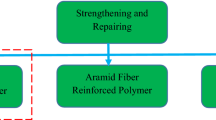Abstract
This paper presents the results of experimental tests on flexural behaviour of reinforced concrete beams repaired by polymer-modified mortar. Tests were repeated varying repair thickness, which included or did not include the steel reinforcement. Also the position of repair mortar was varied, as it was carried out either in the tension or compression region. Finally, the reinforcement ratios of beam sections were also varied. Results were compared with those from control beams, which were tested in non-damaged, non-repaired conditions. Thick repairs that include the longitudinal reinforcement can restore the load-bearing capacity and ductility of non-damaged control beams, whether they are applied in the tension or in the compression region. Thin repairs in tension, which substitute the concrete cover, but do not include the reinforcement, can even decrease the load bearing capacity and ductility of the beam, whereas thin repairs in compression are more effective than those in tension.







Similar content being viewed by others
References
Emberson NK, Mays GC (1996) Significance of property mismatch in the patch repair of structural concrete. Part 3: reinforced concrete members in flexure. Mag Concr Res 48(174):45–57
Engindeniz M, Kahn LF, Zureick AH (2005) Repair and strengthening of reinforced concrete beam-column joints: state of the art. ACI Struct J 102:187–197
European Committee for Standardization (2004) Eurocode 2—design of concrete structures. Part 1–1: General rules and rules for buildings. EN 1992-1-1, Brussels, Belgium
European Committee for Standardization (2005) Products and systems for the protection and repair of concrete structures—definitions, requirements, quality control and evaluation of conformity. Part 3: structural and non-structural repair. EN 1504-3, Brussels, Belgium
Hassan KE, Brooks JJ, Al-Alawi L (2001) Compatibility of repair mortars with concrete in a hot-dry environment. Cem Concr Compos 23:93–101
Jumaat MZ, Kabir MH, Obaydullah M (2006) A review of the repair of reinforced concrete beams. J Appl Sci Res 2(6):317–326
Kim JHJ, Lim YM, Won JP, Park HG, Lee KM (2007) Shear capacity and failure behaviour of DFRCC repaired RC beams at tensile region. Eng Struct 29:121–131. doi:10.1016/j.engstruct.2006.04.023
Mangat PS, O’Flaherty FJ (2000) Influence of elastic modulus on stress redistribution and cracking in repair patches. Cem Concr Res 30:125–136
Nounu G, Chaudhary Z-UL-H (1999) Reinforced concrete repair in beams. Constr Build Mater 13:195–212
Park SK, Yang DS (2005) Flexural behaviour of reinforced concrete beams with cementitious repair materials. Mater Struct 38:329–334
Pellegrino C, Modena C (2002) FRP shear strengthening of RC beams with transverse steel reinforcement. J Compos Constr 6(2):104–111
Pellegrino C, Modena C (2006) FRP shear strengthening of RC beams: experimental study and analytical modelling. ACI Struct J 103(5):720–728
Pellegrino C, Modena C (2008) An experimentally based analytical model for shear capacity of FRP strengthened reinforced concrete beams. Mech Compos Mater 44(3):231–244
Pellegrino C, Modena C (2009) Flexural strengthening of real-scale RC and PRC beams with end-anchored pre-tensioned FRP laminates. ACI Struct J 106(3):319–328
Pellegrino C, Modena C (2009) Influence of FRP axial rigidity on FRP-concrete bond behaviour: an analytical study. Adv Struct Eng 12(5):639–649
Pellegrino C, Tinazzi D, Modena C (2008) An experimental study on bond behavior between concrete and FRP reinforcement. J Compos Constr 12(2):180–189
Pellegrino C, da Porto F, Modena C (2009) Rehabilitation of reinforced concrete axially loaded elements with polymer-modified cementicious mortar. Constr Build Mater 23(10):3129–3137
Río O, Andrade C, Izquierdo D, Alonso C (2005) Behaviour of patch-repaired concrete structural elements under increasing static loads to flexural failure. J Mater Civ Eng 17(2):168–177. doi:10.1061/(ASCE)0899-1561(2005)17:2(168)
Shannag MJ, Al-Ateek SA (2006) Flexural behaviour of strengthened concrete beams with corroding reinforcement. Constr Build Mater 20:834–840
Valluzzi MR, Grinzato E, Pellegrino C, Modena C (2008) IR thermography for interface analysis of FRP laminates externally bonded to RC beams. Mater Struct 42(1):25–34
Acknowledgements
The authors gratefully acknowledge Tassullo S.p.A. that provided materials and specimens for experimental testing, and Eng. Fabio Mazzucco for his contribution to the experimental investigation developed during his MSc thesis. The experimental tests were carried out at the Laboratory of Structural Materials Testing of the University of Padova, Italy.
Author information
Authors and Affiliations
Corresponding author
Rights and permissions
About this article
Cite this article
Pellegrino, C., da Porto, F. & Modena, C. Experimental behaviour of reinforced concrete elements repaired with polymer-modified cementicious mortar. Mater Struct 44, 517–527 (2011). https://doi.org/10.1617/s11527-010-9646-0
Received:
Accepted:
Published:
Issue Date:
DOI: https://doi.org/10.1617/s11527-010-9646-0




